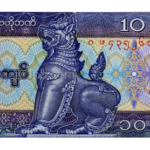When an American traveler picks up a traditional, skirt-like lungi in Myanmar, he has no idea the fashion faux pas that will ensue.
By Rolf Potts
A couple of years ago, while riding my bicycle down Burma’s Irrawaddy valley, I somehow managed to destroy my khaki trousers. These were the only pair of pants I had with me at the time, so I stopped off in a town called Pakkoku and — faced with no other realistic clothing options — purchased a long, cotton lungi to cover my legs for the rest of the trip.
In the event that you aren’t familiar with fashions in this part of Asia, a lungi is a tube of silk or cotton cloth that Burmese men wear around their waists. Essentially, it looks like an elegant, ankle-length skirt. And, unless you count the kilt, there is no fashion equivalent for men in the West.
Thus, having no instincts for wearing a skirt, I encountered all kinds of functional challenges while wearing my new lungi. For starters, I invariably tripped over the hem when walking on any surface that wasn’t completely level. Somehow, Burmese men could stride up staircases in their lungis while still looking perfectly masculine, while I was forced to lift the cloth and mince up slight inclines like some kind of “Gone With the Wind” debutante. Even more difficult was riding my bicycle.
The more the Burmese giggled, however, the better I got at wearing the lungi. By the time I arrived in Rangoon nearly two weeks later, I was able to walk and bike gracefully on all variety of surfaces. Impressed locals gave me the thumbs-up at the sight of my dapper Burmese threads, playfully asking me if I was from Burma.
I had, it seemed, successfully “gone native” with my travel wardrobe. And it felt good.
When I flew on from Rangoon to Bangkok, however, I quickly learned that – – by backpacker fashion standards — going native is far more complicated than simply buying local clothing and learning how to wear it.
As I strolled in my new lungi through the Khao San Road backpacker ghetto (where I’d hoped to buy a new pair of khaki pants), I noticed that many of my fellow travelers were giving me funny looks. Since Khao San is a place where Westerners with, say, chicken bones through their noses and dreadlocked armpit hair hardly garner a second glance, I wondered what the problem was.
That afternoon at my guesthouse, a sun-browned Australian traveler clued me in. “Look at ya, mate,” he said. “You’ve got it all mixed up.”
I looked down at my outfit. In addition to my lungi, I sported a nylon fanny pack (which made up for my lack of pockets) and a North Face dry-wick shirt (which had kept the sun off while biking). This ensemble didn’t strike me as particularly strange, but — according to the Aussie — wearing a fanny pack (stereotypically favored by middle-aged tourists) and a boutique safari shirt (which, while functional, is the modern fashion equivalent of a pith helmet) effectively canceled the lungi out.
The problem, it seemed, wasn’t that I had “gone native,” but that I had gone native in an incomplete and bourgeois manner. “From the looks of it,” he said, “you don’t know if you just walked out of a jungle or a shopping mall.”
Going native to one degree or another, of course, has always been a part of the travel experience. Until the past couple of centuries, in fact, going native wasn’t a travel option so much as a travel necessity. From Herodotus to Marco Polo to Lewis and Clark, eating local cuisines, learning local languages and wearing local clothing was simply how the traveler survived in foreign lands. This all changed, however, as British travelers and expats alike were increasingly expected to maintain the same decorum overseas as applied back home. Fraternizing with locals was discouraged, safari parties trotted off into foreign jungles sporting woolen raiment and, as late as the 1930s, officials of the British Empire could be fired for wearing native clothing.
What this colonial protocol overlooked, of course, was that going at least partially native has always been an important step in experiencing other cultures. Wearing native clothing isn’t necessarily a prerequisite, but abiding by local dress codes (particularly in regard to modesty) is essential if you want to be accepted within the cultures you visit.
But it’s often difficult to determine where the propriety of “going native” begins and ends. Travel is not the same as emigration, after all, and no combination of culinary and fashion savvy can truly make you a part of your host culture. At some point, then, many attempts to “go native” cease to be an inquiry into other cultures and begin to be a token of status within travel culture itself.
In “The Songlines,” Bruce Chatwin observes that nomadic animal species tend to be less dependent upon hierarchies and shows of dominance, since the hardships of the journey naturally weed out the weak. However, now that humans’ nomadic life rarely involves natural selection, travel culture seems to have utilized fashion as one subtle kind of litmus test. Ostensibly, a Shan jacket worn with a Mao hat and cotton pajama bottoms implies that you had the Darwinian oomph to survive northern Burma, communist China and the Punjab. As with all fashions, however, the accepted vogue for going native tends to be fickle. In Jordan, for example, scores of Westerners trade ball caps for Arab khaffiyeh scarves to better keep the sun off — but few of those same travelers would don conical peasant hats for the same purpose in Vietnam.
In the end, then, “going native” is a mixed endeavor — part attempt to understand your host culture, and part extension of how you want to selectively showcase your travels to others. Properly balancing these urges is part of the challenge and fun of travel.
Just for the record, I now own three Burmese lungis — two cotton and one silk. I find them comfortable, functional, and stylish. And chicks dig the look.
But until they make them with pockets, I will — fashion be damned — continue to wear them with a fanny pack.
This essay originally appeared in the San Francisco Chronicle on March 14, 2004.





